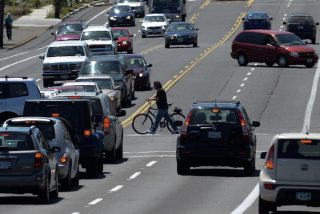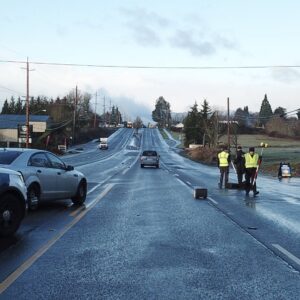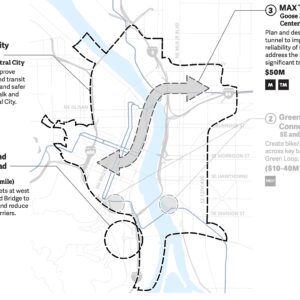
(Photo: J. Maus/BikePortland)
In what’s being hailed as an unprecedented moment for regional transportation reform, Metro Council voted unanimously on Thursday to adopt the Get Moving 2020 plan and send it to voters in November.
Centered around 17 “investment corridors,” the plan could pump nearly $8 billion into regional transportation infrastructure and programs over the next 20 years. If approved, the measure would start generating revenue in 2022 with a 0.75% payroll tax paid by employers of businesses with over 25 employees. (UPDATE: A last-minute amendment exempts all state and local government agencies.) Metro’s latest pitch has framed the proposal as a massive jobs package that will put over 37,500 people to work with high-paying construction and consulting jobs.
Metro spent over 18 months negotiating the details of this package. While it’s not perfect and has received very mixed reviews from transportation reform activists, the overall feeling seems to be that the myriad benefits of the “good” projects and programs far outweigh the few “bad” projects that made the cut.
Some of the good includes:
- $700 million for better bikeways, off-street path connection, bus rapid transit and much more on Tualatin-Valley Highway.
- $65 million to kickstart Albina Vision Trust’s plans (that are totally separate from ODOT’s I-5 Rose Quarter project).
- $540 million to makeover 82nd Avenue between Highway 224 and NE Airport Way that will lead to jurisdictional transfer from ODOT (bad) to PBOT (good).
- $9 million per year for free bus and MAX passes to all high school-aged youth in the greater Portland area.
- $11.5 million per year for “Community Stability” which includes affordable housing, main street upgrades, and anti-displacement strategies.
Advertisement
Then there’s the $150 million for the “Clackamas to Columbia” corridor that will build new roads for more driving capacity in Gresham, a new overpass on Airport Way, and $975 million for a SW Corridor MAX light rail project that’s still too car-centric and has uncertain ROI.
Beyond the projects, one big takeaway from how this proposal came together is who put it together. “With this measure we took that mold which we have been using for the last 70 to 80 years and we just broke it,” Metro Council President Lynn Peterson said during her testimony yesterday. “And in its place we relied on public engagement and a transparent process to create a measure based on the shared values and needs of this entire region.”
The Getting There Together coalition deserves high praise for their work in bending the proposal away from traditional driving and highway-centric projects and toward basic safety (like street lighting, better bike lanes and sidewalks) and major transit upgrades.
And Metro was intentional to make sure the investments went in places that will benefit low-income and people of color. 68% of the region’s people of color live in the areas targeted for funding and new infrastructure. Transit investments — including 85% of new transit signal priority projects and 59% of new bus lanes — are strongly weighted toward areas where people of color live.
For veteran environmental and social justice advocate Vivian Satterfield of Verde NW (a member of the Getting There Together Coalition), these investments are exactly what residents of northeast Portland’s Cully neighborhood have been clamoring for. During testimony at yesterday’s public hearing she said, “For low-income families and people of color living, working, learning and playing in this region, we’ve always talked about our frustrations and needs from our transportation systems… And the reality of cycling through cheap junk cars on Craigslist just to have a way to get to daily activities because our current system doesn’t get people to the places they need to go in a time they have to travel.”
In such a dark news cycle, it was heartening to see optimism and gratitude from many people like Satterfield yesterday. And the united front from Metro Council who showed no fear of threats from big business interests planning to oppose the measure was also a welcome sight.
Will it pass? Given the crowded ballot and hefty opposition, it could be very close. But these are not normal times and it’s hard to predict anything. Stay tuned.
— Jonathan Maus: (503) 706-8804, @jonathan_maus on Twitter and jonathan@bikeportland.org
— Get our headlines delivered to your inbox.
— Support this independent community media outlet with a one-time contribution or monthly subscription.





Thanks for reading.
BikePortland has served this community with independent community journalism since 2005. We rely on subscriptions from readers like you to survive. Your financial support is vital in keeping this valuable resource alive and well.
Please subscribe today to strengthen and expand our work.
Bus rapid transit and a protected path on the south side of ODOT’s Highway 8, TV Highway, would be fantastic, but what will it mean if Washington County doesn’t change their land-use? That stroad has so many drive-throughs and car dealerships. I hope the railroad stays.
TV highway south side (eastbound) doesn’t have many drive-ways except very close to Beaverton, and perhaps from Hillsboro to Cornelius. From Hillsboro to Beaverton there aren’t many driveways, and there is already a very wide shoulder (guessing 6-8 feet), so it’s not bad. The north side (westbound) is pretty good from Beaverton to 170th. If I need to go north past that point I usually use the side streets.
About forty people have died on Highway 8 since 2003. Auto row has taken over Canyon Road in West Slope.
Metro is out of control.
I am hoping another agency comes up with another 4 Billion dollar bond, so we can have a total of 10 Billion (Metro, Schools, TBD) put before voters this year.
TBD-Potential Parks & Recreation bond measure for voters to consider
https://www.oregonlive.com/portland/2020/07/portland-considering-november-ballot-measure-for-tax-levy-to-fund-parks-system.html
Their insistence on the overpass at Airport Way is so bewildering to me. The minor bottleneck for car traffic there is nothing compared to the bottleneck at their actual destination: the Arrivals and Departures hubs at the airport. All this will do is get cars to join the long lines snaking from Arrivals and Departures a little bit faster.
Meanwhile, getting to the airport without a car is an enormous pain if you don’t happen to live near a Red Line stop. Why why why are there no bus routes to the airport?
It’s served by MAX. The expectation is that everyone will take a bus to the nearest MAX station.
I live nowhere near a MAX line, and find it very easy to get to the airport on transit. Bus+train has been more reliable than the one time someone in my household scheduled a cab.
MAX is great, when and where it works. It’s not so great when the Steel Bridge is out of commission. It doesn’t take an earthquake to shut down the Steel Bridge, sometimes it just takes a Tuesday. MAX is also vulnerable to predictable local weather. If the temperature is high the tracks buckle. Snow and ice can lock up switches.
Some network redundancy to a common destination like the airport might not be a bad thing, especially since many airport workers don’t actually live on the Red line.
If only TriMet new what “feeder routes” were instead of using bus routes to cannibalize its own MAX service.
With Biketown’s new rules change – allowing youth access to bikeshare – I hope this METRO package once approved by voters tweaks the “$9 million per year for free bus and MAX passes to all high school-aged youth” to also include youth access to “bike transit” aged 16 and older.
[Our Biki bikeshare service in Honolulu has always allowed youth aged 16 & 17 to be members – with parental approval – and they have been as good of customers as adults, I hope Biketown has a similar experience.] https://gobiki.org
One huge item not mentioned in the article…government agencies/workers don’t have to pay the tax. Only private companies/employees. I consider that a significant hurdle
You are correct – such a provision will enrage voters – it will have no chance of passing, but it speaks volumes as to what they think of WE THE PEOPLE.
Doesn’t that violate some kind of equal protection under the law concept? Even if it doesn’t, it’s outrageous that they would even consider such a slap in the face to non-government voters. How many government employees lost their job this year? How many private employees lost their job?
It’s funded by a “0.75% payroll tax paid by employers of businesses with over 25 employees”: so not-for-profit entities like NGOs and governments will not pay, because they are not businesses. It doesn’t make sense to tax the City of Gresham or school districts to pay for this, since they are funded by other taxes.
The employees don’t pay directly – of course in theory the business will consider this <1% tax when considering raises and hiring decisions, in practice employees will not be immediately impacted.
Let’s check their claim about 37,500 “high-paying” jobs. Per the above numbers, $8,000,000,000 over 20 years comes out to $400,000,000 per year. If you divide that by the 37,500 “high-paying” jobs, you get $10,666.67 per job per year. And the real number would be less since a chunk of the money will go toward materials, permits, studies, possibly land purchases,etc. Wonder where the materials they will buy are produced? How about the consultants and construction companies – will those be local firms?
Good question, and the answer that comes to mind is that jobs don’ t last 20 years anymore. A year’s work for one person on a construction project = one “job”. A bid accepted from a small consulting company = three “jobs”, perhaps. It’s completely possible that one person who works on different phases of the 20 year proposal could account for half a dozen “jobs” and still have need for other employment in between.
I don’t know what you call this. It’s not doublespeak but it’s in the same category.
These sort of analyses assume that there is a multiplier: if you create one direct industrial/construction job, which pays 1 worker $60k per year, then that worker will spend money on shopping, food, entertainment, transportation, etc – and each dollar spent will recirculate through the local economy several times. So that number of jobs is not the number directly created by hiring people to do the work, but a somewhat generous assumption about how much the economy will grow due to the additional spending.
Good point, but all that money ends in someones pocket. it doesn’t evaporate in the material acquiring, permitting, studying, etc… I agree that the fine print should include localizing as much of these processes as possible, though.
I love Lynn Peterson. I’ve worked in urban planning and bike and walking advocacy for 20 years and always vote YES on the Metro bonds…not this year. Education, schools (especially PPS) desperately needs the money. This strikes me as tonedeaf this year and I’ll be voting NO. Also, I don’t support the SW LRT although in another year I would vote yes regardless.
TV Highway needs the investment and total change. Schools have already received the cash.
Thank you for reporting on this, Jonathan. I hope you will have time to look closely at the details of this measure. Would it be possible to write articles about the bus lanes and other bus improvements that would be funded by this measure? It would be great to talk about each of the bike-related improvements as well.
I’ve heard Washington County and ODOT are thinking of ideas of TV Highway of having it become one-way for the bus-rapid transit and then putting the car lanes to the south of the active railroad tracks. I want protected bike lanes on that deadly slice of land.
Let’s go!!
The referring resolution includes language that calls for utilizing “participatory budgeting principles for resource allocation for the anti-displacement program.” Not sure what “participatory budgeting principles” means. It sounds a little fishy. Either you share real power over public real money to tap the community’s expertise and increase transparency and accountability or you don’t. Still this is could be an important, small step toward democratizing and humanizing transportation investments in our region. Kudos to the Getting Their Together Coalition for the hard work in vastly improving this proposal for all people and the planet and for specifically advocating for PB.